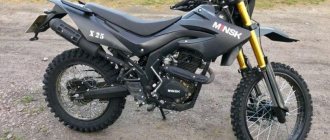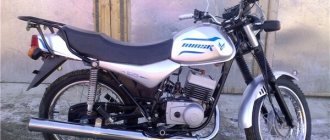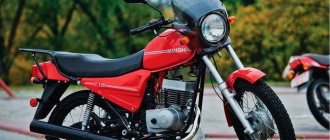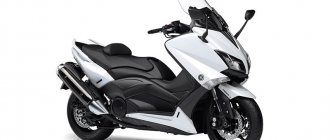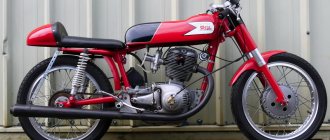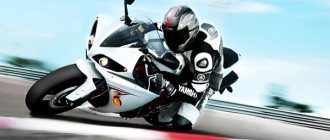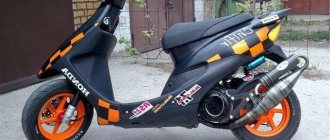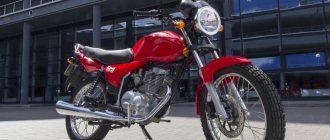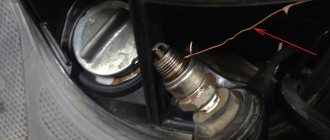How to properly break in a motorcycle
When you buy a new motorcycle, the problem of running it in immediately arises. In general, everything is written in detail in the user manual, which should come with every new motorcycle. And it says almost always the same thing, namely: “For the first 500 km, do not try not to turn the engine above half the possible speed, after 500 km and up to 100 km, turn it up to 2/3 of the speed, then change the oil and turn it all the way up.” " The mileage and rev range numbers may differ slightly - this is not fundamental. But there are also opinions that it is necessary to break in completely differently from what the manufacturer requires. Namely: the new motorcycle must be started, warmed up, and during the first 100 km it must repeatedly see both the maximum speed and the cutoff. Then you should drain the oil with aluminum shavings, fill in new oil and rejoice at the successfully completed break-in. So what to do?
Firstly, a modern engine does not care how you are going to break it in - it has already been sufficiently tested at the factory. Therefore, it will not be possible to make it much worse or much better. Here are a couple of videos demonstrating the assembly of BMW and Ural motorcycles, which shows that after assembly the motorcycles are raced on a dyno, although the engines have already been there during the assembly and quality control process.
Secondly, I have had the opportunity to test drive a number of motorcycles fresh out of the box. It is clear that their “light running-in” took place just long enough to leave the populated area and get to the nearest mountain pass. Then the motorcycles spun into the cutoff and none of them died. The further fate of most of them is unknown to me, but some time later I rented one of these motorcycles. I must say that there were no signs that the engine was damaged in its youth.
So why is this run-in needed at all? The fact is that the pistons in the cylinders must rub the rings against the cylinder walls. In addition, there are other rubbing surfaces such as camshafts, bearings... The better the grinding of the rings, the less compression losses there will be, correspondingly higher compression and more power produced. The absence of deep scratches will extend the life of other rubbing surfaces. If there is a desire for perfectionism, then before the first oil change at the 1000 km mark, the motorcycle should be run in according to the manufacturer’s recommendations. However, for some reason, some people think that during break-in you need to vomit boringly at the speeds indicated in the user manual. This is not true at all... The following is a translation from the GSXR 250 user manual, which quite clearly states how to drive during break-in.
MAXIMUM ENGINE SPEED
We skip recommendations for maximum speed, since they will be different for each specific motorcycle...
VARY ENGINE SPEED
The engine speed (its revolutions) should vary within the recommended limits; do not allow driving at a constant speed. This allows the parts to be “under load” and also gives time for cooling. This helps the lapping process.
During the break-in process, it is necessary that the engine parts are subjected to some load. However, do not overload the engine.
AVOID CONSTANT LOW SPEED (meaning engine speed, i.e. RPM)
Running the engine at constant low speed (low load) can cause parts to become shiny and improperly seated. During break-in, accelerate using all gears, making sure that the speed is within the recommended values. However, do not open the gas to 100% during the first 1600 km.
ALLOW THE ENGINE OIL CIRCULATE THROUGH THE ENGINE BEFORE DRIVING
Before driving, let the engine idle for some time. No matter whether the engine is cold or hot, allow the engine to warm up a little before subjecting it to load or revving. This will help the engine oil reach all critical engine components.
PAY CAREFULLY TO THE FIRST AND MOST IMPORTANT SERVICE SERVICE
Service for 1000 km is the most important service for a motorcycle. During the break-in period, some engine components underwent initial wear and grinding. It is necessary to carry out adjustments and change the engine oil along with the filter.
At this point, the service manual considers that enough has been said about break-in, and moves on to cover other things. As you can see, if you carefully read the user manual that comes with every new motorcycle, then there are no contradictions with the “load the engine from the first kilometers” theory. It is proposed to still alternate engine acceleration and braking, with the only difference that there is a call not to exceed certain speeds for the first few hundred kilometers. From the point of view of a smooth increase in load, this makes sense. But as practice shows, modern motorcycle engines can withstand more barbaric “break-in”, a description of which can be found on the Internet if desired.
Official Yamaha Motor Dealer
Breaking in a new motorcycle is a technique for getting the motorcycle up and running as defined by manufacturers and hobbyists. It occurs during the first 1000-1500 km on the road. During this process, internal friction in the engine reaches its peak, since the parts are new and not yet “cut.” As the first 1000-1500 km are reached, friction decreases significantly. Manufacturers claim that a well-run-in motorcycle produces fewer emissions, is more economical and lasts longer. In addition, other key components function better and longer. After purchasing a vehicle, motorcyclists scour the Internet far and wide in search of the correct break-in technique. They are looking for a better method than the one described by the manufacturer in the instruction manual. However, if such a method existed, the manufacturer would be the first to know about it. The Wrong Way to Break -in Many self-taught motorcycle break-in experts say that the best way to break in your bike is to ride it like you're driving it. You shouldn’t listen to them, as the metal parts wear off and it all ends up in the engine oil. Driving for a long time at maximum speed can cause metal shavings to clog the oil filter and enter the engine. The correct way to break in The best way to break in a new motorcycle is described in the instructions. Before the manufacturer puts the bike into operation, quality control is carried out on a dynamometer - this is where the motorcycle’s running-in begins. Despite the fact that manufacturers differ slightly from each other in their recommendations for break-in, they agree in many respects - you need to: 1. avoid pressing the gas pedal more than 3/4 for the first 1000-1500 km. 2. avoid high engine speeds. 3. do not brake or start too quickly, even in emergency situations. 4. During break-in, increase the engine speed to the limit for short periods of time. 5. do not overstress the motor. You must downshift before the motorcycle starts running. 6. do not drive unnecessarily. Shifting up one gear improves fuel consumption, calms the bike and helps save the environment. Poorly run-in motorcycles are at risk of high fuel consumption and poor performance. Motorcyclists who have run their bikes in a “different” way or simply incorrectly turn to a repair shop more often.
19.06.2017, .
How to properly break in an engine?
There are several key recommendations that are suitable for each engine during break-in:
- Try to reduce the time the car idles;
- Minimize the number of sudden accelerations and sudden braking - perform all actions to increase and decrease speed smoothly;
Interesting materials:
At what age do children start eating solid foods? Why do beavers eat wood? Why eat eggs every day? Why eat seafood? Why do female praying mantises eat males? How to glue leaves for applique? How to glue leaves for herbarium? How to treat a pear If the leaves turn black? How to treat tomatoes to prevent leaves from curling? How to spray trees to prevent leaf curl?
Breaking in a motorcycle - Principles
Many bikers find break-in to be restrictive. Most of them don't even spend more time on this, considering this step unnecessary. Which is completely false.
Of course, even without running it in, the bike will still work. However, since all its constituent parts are new, they will never be able to perform at their best unless they are prepared for this. And this affects all the elements that make up the car: the engine, but also the brakes and the same tires
.
That's why break-in needs to be done gradually. It's not about riding 1000 km in one go, pushing the bike to its maximum performance. On the contrary, the principle of break-in is simple: gradually adapt the bike until the mechanical parts get used to it. Only under this condition can you enjoy a powerful, reliable and durable machine.
